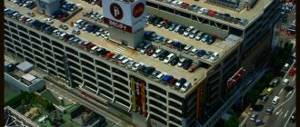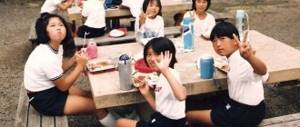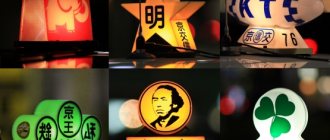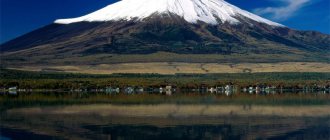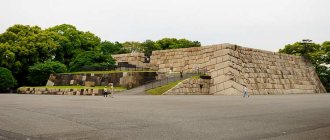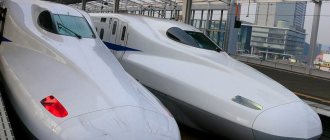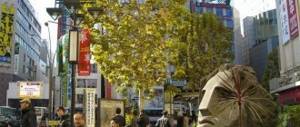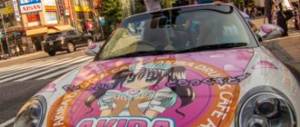Japanese geisha in a bamboo grove
Tokyo is the city of the future. The threads of the past and new technologies intertwine here. This is the city that never sleeps. Life pulsates in Tokyo with bright reflections and is not going to stop. There will never be a dull moment here.
Tokyo - the city of the future
This is one of the best places to get acquainted with the latest technical innovations, see modern robots, and meet artificial intelligence. But Tokyo is also a city that carefully preserves traditions and passes them on to future generations.
Japanese rolls
Japanese gastronomy is one of the most delicious in the world. Gourmets will appreciate it. Tokyo is especially famous for its seafood. Where else if not here to try sushi?
Best places in Tokyo
Since the 17th century, Tokyo has become the political, cultural, and economic center of the country. Therefore, all the most significant sights of Japan have been preserved in the city. The greatest preservation is found in cultural monuments that are associated with the life of the imperial family and the main clans of the country.
Imperial Palace
Imperial Palace in Tokyo
This is one of the main attractions of the city and the country. The Imperial Palace covers an area of more than 2,000,000 square meters. The flight of vehicles over the territory of the palace complex is prohibited so that the peace of the imperial family is not disturbed. The garden around the imperial palace is beautiful at any time of the year. Especially, newlyweds love to visit it for a wedding photo shoot in the spring during the plum and sakura blossom season.
Disneyland
Tokyo Disneyland
Tokyo Disneyland covers an area of approximately 115 acres. This is one of the main entertainment venues in the country. The opening took place in 1983, and since then the amusement park has attracted both adults and children. The entire complex is divided into thematic zones: Westernland (Wild West), Fantastyland (Fantasy World), World Bazaar (World Bazaar). In addition to the main attractions, each zone also has all the necessary infrastructure. There is a huge selection of cafes, restaurants, hotels, shops. The themed areas are connected by a railway, which makes it convenient to get to different parts of Disneyland.
Tokyo Sky Tree
Sky Tree in Tokyo
The Tokyo Sky Tree claims to be the tallest building in Japan. The spire of the television tower soars up to 634 meters. To illuminate the building, only two colors are used, replacing each other every other day: blue and pink. Tourists are attracted to the tower mainly because of the observation deck. In addition, there is a wonderful restaurant and shopping center.
Edo-Tokyo Museum
Edo-Tokyo Museum
This is a historical museum that will take you back in time and show you how Tokyo has developed over the centuries. The museum displays full-scale replicas of old feudal houses, a theater, and city walls. Among the museum's exhibits are many ancient manuscripts, maps, and documents.
Ryogoku Kokugikan (National Sumo Hall)
Ryogoku Kokugikan (National Sumo Hall)
To get acquainted with the unique culture of Japan, the Hall of National Martial Arts is the best place. Kokugikan hosts competitions not only in sumo, but also in boxing and wrestling, and the premises are also used as a concert venue. But a tourist should come here, of course, for sumo. To learn all the secrets of ancient martial arts, first look into the museum, and then you can take your seats in the hall. Sumo is a century-old tradition in every movement and surroundings: a special form of hairstyle for sumo wrestlers, a special outfit of judges, rituals before the fight. The spectacle is fascinating!
Shinjuku Imperial Garden
Shinjuku Imperial Garden
Many people think that Tokyo is a large metropolis consisting entirely of glass and concrete. But it is not so! The city still has green oases, and the Shinjuku Imperial Garden is one of them. The Imperial Garden is divided into three thematic zones: the Japanese Garden, the English Garden and the French Garden. The Japanese garden is especially beautiful in early spring, when the cherry blossoms begin to bloom. These days there are especially many vacationers and tourists in the garden.
Kabukiza
Kabukiza
Kabuki is a traditional Japanese theater. If you want to see a classical performance, then Kabukijo is your place. Here you will find a great show, with amazing artists, and the theatrical plot twists are a pleasure to follow. Keep in mind that the duration of a theatrical performance is twice as long as European productions and can reach up to 4-5 hours.
National Museum in Tokyo
National Museum in Tokyo
One of the most famous museums in Japan is located in Ueno Park. It's worth going here to learn more about the history of the city and Japan. Under the arches of the National Museum, works of Japanese art are collected: ceramics, sculpture, weapons, engravings. One of the halls displays a collection of kimonos, which are hand-embroidered with gold threads. Try to set aside a few hours to visit the museum, it's worth it.
Imperial Palace
The Imperial Palace is the main and most popular attraction in Tokyo. It has been located on the territory of the former Edo Castle since the mid-19th century. The fortress in the center of the metropolis includes 2 ground floors and 1 underground. Massive walls and wide ditches isolate this symbol of statehood from the bustle of the metropolis and simply attract the attention of tourists. The architecture is in a traditional style, restrained and simple. Unfortunately, you can only admire this majestic building from afar. Entrance to the palace for outsiders is prohibited. But even from a distance, the imperial palace is remembered for its grandeur and aura of power.
What to see in Tokyo in 3 days
Tokyo is beautiful at any time of the year, but especially in spring and autumn. For a short trip, you should choose weekdays to have time to enjoy the main attractions, bypassing the tourist flow. For Tokyo, 3 days is, of course, not enough. But it’s enough to plunge into the unique atmosphere of Japan.
Ginza
Ginza
The first place to go is the Ginza area. These are several blocks located next to the Imperial Palace. Here all the contradictions of a large metropolis and the traditional Japanese way of life met and intertwined. Fashion boutiques coexist with kabuki theaters. And next to the stores of world brands there are authentic Japanese restaurants. On weekends, part of the block turns into a pedestrian zone, where it is pleasant to stroll while looking at the neon lights of Tokyo at night.
Tsukiji Fish Market
Tsukiji Fish Market
Another metropolitan attraction that is in demand among tourists, although it is not intended for them. This is a wholesale fish market where the hottest auction battles for sea trophies take place. The Tsukiji market begins its work at 4 am; to get here you must register in advance. From here, tons of fresh fish are shipped daily to restaurants throughout Tokyo. The most interesting auction takes place in the battle for tuna. The cost of fish can reach several thousand dollars per unit. Many gourmets consider a visit to the Tsukiji Fish Market the highlight of the year.
Odaiba Island
Odaiba Island
This is an artificial artificial island that was originally intended for military purposes. An artillery battery was located here in the 19th century. Then warehouses and port facilities appeared on the island. And at the end of the 20th century, the capital authorities decided to carry out a large-scale reconstruction to develop Odaiba with residential and commercial real estate. Today it is one of the elite areas of Tokyo, where the headquarters of large Japanese companies are located. It is also worth going here to improve your tan on the sandy beach of the island. The beach is known for its unusual attractions, such as a replica of the Statue of Liberty.
Senso-ji Temple
Senso-ji Temple
According to legend, the temple was founded in the 7th century in the place where the golden statue of the goddess of mercy Kannon was found. Today the temple is one of the main attractions of the Japanese capital. The entrance to Senso-ji Temple begins at the "Thunder Gate". Here you can find out your “destiny” in Japanese. If you come across a bad prediction, you can leave it in the temple; if it’s the other way around, you can take it with you. The Senso-ji Treasury contains ancient manuscripts and Buddhist religious artifacts. Believers often come to the temple to take incense. They believe that he has healing powers and is able to cure diseases. Next to the temple there is an old shopping street where you can buy traditional Japanese crafts.
Tokyo Metropolitan Government Building
Tokyo Metropolitan Government Building
For several years the building held the status of the tallest in Japan. An observation deck is open to visitors on the 45th floor. From a height of 200 meters, a picturesque panorama of the entire city opens up, and in clear weather you can see Mount Fuji, sacred to the Japanese. Surprisingly, you can visit this site absolutely free. There is a green park around the government building that children will especially enjoy.
Karaoke
The birthplace of karaoke
Everyone knows that Japan is famous for its karaoke bars. Karaoke here is a favorite pastime for residents of the metropolis. Everyone sings here: both old and young. Considering this, you should definitely spend time on the main entertainment of the Japanese. One of the most famous karaoke bars in Tokyo is called Karaoke Kan. This place gained popularity after the release of the film Lost in Translation starring Bill Murray.
Kabuki-za Theater
The Kabukiza Theater is one of Tokyo's main cultural attractions. The originality of Japanese culture is clearly visible in the performing arts. Initially, entry to the theater stage was closed to women. All roles were played by men, using complex makeup and bulky costumes. The Kabuki-za Theater is located in the Ginza district and at first looked like a simple wooden structure. Later, the theater's home became a baroque building that was destroyed during the hostilities of World War II. And only in 1950 it received its modern appearance. Music, drama and dance form a surprisingly bright and colorful performance, sometimes lasting several hours.
What to see in Tokyo in a week
Sakura blossom
In seven days in the city you can see all the main attractions and enjoy the hospitality of the capital of Japan. Among the compulsory programs, it is worth paying attention to Buddhist temples and monasteries, visiting sumo fights, parks and national museums.
Miraikan (Museum of the Future)
Miraikan (Museum of the Future)
To understand why the capital of Japan is called the city of the future, just come to Miraikan - the National Museum of Advanced Science and Technology. The museum contains all the latest achievements of Japanese scientific thought in the field of genetics, robotics, chemistry, and medicine. The ASIMO robot is a constant success among visitors because it can perform complex tasks, for example, it can hit a ball or carry on a conversation with a person. The museum is interactive, all the exhibits can and should be touched, tried, pressed buttons and studied in every possible way. Here you can also feel like a pioneer and dive to the seabed in a submarine. Or conquer the silent space of space. A number of exhibits will allow you to “survive” an earthquake and even a storm.
Sumida River Cruise
Sumida River Cruise
To see the city from a new perspective, take a river cruise. The duration of the trip depends on the chosen route. The shortest cruise lasts only 30 minutes. Of course, the Sumida River is not the most beautiful river in the world. It cannot be compared in any way with the canals of Venice, nor with the canals of Amsterdam or St. Petersburg. But from the river you can see all areas of the city.
Kamakura
Kamakura
This is one of Japan's ancient cities and is ideal for a day trip from the bustling capital. Kamakura is known for its amazing architecture. The city is home to several Buddhist temples that are significant for Japan. These are Engaku-ji Temple and Tsurugaoka Hachimangu Temple. The second largest Buddha statue in Japan is also located here, its height is over 11 meters and its weight exceeds 90 tons. All Kamakura temples are integrated into the surrounding landscape: green hills rise on three sides, and the sea on the fourth. Nearby there are ponds in which white and red lotuses grow.
Meiji Shrine
Meiji Shrine
Meiji Shrine is dedicated to the Japanese Emperor Meiji and his consort. Unlike Senso-ji Temple, this is a Shinto shrine. The temple appeared at the beginning of the 20th century, but did not last long. The fighting during World War II led to the complete destruction of the temple. After the end of the war, the temple was restored, and a classical Japanese garden was laid out around it. There is a relaxed and serene atmosphere here, where you can take a pleasant break from the noise of the big city.
Restaurant Robots
Restaurant Robots
One of the most interesting places in the capital of Japan is the Robots restaurant, which hosts demonstrations of robotics and live actors and dancers. The establishment does not offer haute cuisine, but here you can watch a unique musical and theatrical performance. During intermission, don't forget to take a photo with the performance participants.
Onsen (hot springs)
Onsen (hot springs)
Another element of traditional Japanese culture is visiting hot springs. In a country where high volcanic activity remains, thermal springs are found everywhere. It is customary for families or large groups to come here. Oedo Onsen Monogatari offers visitors not only relaxation in hot water, but also massage. Here you can also try sake or find out your future from a fortune teller.
Yokohama
Yokohama city
If you are in Tokyo for several days and are thinking about exploring the surrounding area, then visiting Yokohama would be your best choice. It is rather not a city, but a suburb of the capital of Japan. Yokohama is only 30 km away. The Port of the Future is being built on the reclaimed territory by the sea. The Silk Center offers you to purchase goods of the highest quality, and the Silk Museum will tell you and show you the process of producing openwork fabrics that are used to make kimonos. An impressive Ferris wheel will show you the city from a height of several hundred meters. Finally, you can stroll through authentic areas of Yokohama, such as Chinatown.
Tokyo National Museum
Among the most popular tourist attractions in Tokyo, the Tokyo National Museum occupies a special place. The giant cultural center includes 5 buildings, where about 90,000 exhibits are stored. 100 thousand m² preserve the memory of the country's history framed by a luxurious landscape. The main building, Honkan, houses objects, costumes and decorations of the Kabuki theater, drawings and painted screens in its exhibitions. The most popular exhibit of the museum for many years has been samurai armor. The ceremonial building was built in 1909. Externally it looks rather discreet, but the interior decoration corresponds to its original purpose. Nowadays, the building has become an educational center. The Eastern building, Toikan, houses exhibits from many countries; they symbolize the cultural ties of the country. The Heisei building is relatively young, it was built in 1999. Its exhibition includes treasures from the largest Horyu-ji temple in the city of Nara.
Robots
Most people know that the Japanese are obsessed with futuristic technology , especially robots. You probably expected a lot from the country that created ASIMO, a monstrously realistic humanoid robot that can run, walk, climb stairs and bring you tea. Now the Japanese are developing human-like robots, and newer versions have the ability to express emotions and even smile and blink. One of the latest robots is an attractive female humanoid that is programmed to strut down the catwalk. There are also Japanese robots that can take the place of pets, help the elderly, and even become the best friend of a lonely child.
Akihabara
Without a doubt, Akihabara is one of the most famous electrical districts in the world. The area developed greatly for the first time through the mass production of household electrical appliances, and a period of rapid economic growth saw the opening of many music stores specializing in records and CDs. Later, many game stores opened. The development of these trends led to the opening of hobby stores, as well as anime stores.
On one side, Akihabara is an electrical district, and on the other, a subculture district with amateur radio stations, anime, manga and dotaku games. There are a lot of shops here for anime and game lovers, selling goods for the so-called otaku: game software, DVDs, manga, magazines, plastic models, figurines, trading cards, cosplay items and even model trains.
Cosplay
Cosplay is in some ways an art form. People dressing as everyone's favorite manga or anime characters are now gaining popularity in many countries around the world. If you're lucky enough to wander around Harajuku on the weekend, you might dress up as a gothic rock star, a lolita, a French maid and a glitzy video game character.
Yasukuni Shrine
To the north of the imperial palace is the controversial Yasukuni Shrine, built in memory of fallen warriors. Unlike most Shinto shrines, they do not worship kami, but the souls of warriors who died for Japan and the emperor. The temple's presiding deity is the Emperor of Japan. Japanese soldiers fought in the knowledge that their souls would find peace and honor at the Yasukuni Shrine after death. The shrine still causes a lot of controversy in Japan; the temple is run by the military and is considered a symbol of Japanese militarism.
Official website: www.yasukuni.or.jp
Guide: Nagasaki Attractions
Route 6. Tokyo Disneyland - a fairy tale for children and adults
In this article we look at things to do and attractions in Tokyo. Disneyland is located in a suburb called Urayasu.
The park can be reached by taking the Keiyo Line JR. From Tokyo Station to Maihama Station.
There are two parks nearby - Disneyland and Disney See. The second one is more suitable for older children. You need to set aside a whole day to visit each theme park. Be prepared to spend a lot of time standing in line.
Ticket sales begin three months before the visit. You can buy on the official website or from agents
. You can purchase a ticket with an open date or a fixed date - this factor does not affect the cost of the ticket. A ticket with a fixed date has the advantage that you are guaranteed entry to the park, but if your plans change, then making changes to the ticket is a paid procedure.
We bought at a discount
.
Tickets can be purchased for 1, 2, 3 or 4 days: 1 day - adult - 7400 ¥, teenagers (12-17 years old) - 6400 ¥, children (4-11 years old) - 4800 ¥ to one of the parks; 2 days - 13200 / 11600 / 8600 - you cannot visit both parks in one day; 3 days - 17800 / 15500 / 11500; 4 days - 22400 / 19400 / 14400 - two days entrance only to the main park, third and fourth - any.
The park has seven thematic zones. See the attraction map
.
| Like any major theme park, Tokyo Disneyland is a full day trip. |
.
Kawaii
In Tokyo, you can't take more than a couple of steps without ignoring the cute toys of Hello Kitty, Totoro, Grim Bear or miniature plastic sushi. The Japanese are passionate about Kawaii (which literally means cute, lovable and adorable), and Tokyo's love for all things cute only adds to their liking.
Hayao Miyazaki and Studio Ghibli
Hayao Miyazaki is the godfather of Japanese animated films and a national treasure, the Japanese version of Walt Disney. Miyazaki is the co-founder of Studio Ghibli , founded in 1985. The animation studio has produced such high-grossing films as Spirited Away and Howl's Moving Castle. The studio also houses a museum, a carefully designed attraction to attract visitors. The museum (unsurprisingly, a Mecca for anime fans) was created by Miyazaki himself and has the motto: “Let's get lost together.”
Trains
The Japanese take trains and the rail network system very seriously. Tokyo's trains and railways are second to none for cleanliness, efficiency and punctuality - you can literally check the clock by them. Trains are a good way to enjoy a journey that will probably leave you wondering why your city's public transport system is rubbish in comparison. The bullet train, which travels at speeds of up to 300 km/h, is one of the most important modes of transport, traveling from Kyoto to Tokyo (especially recommended for enjoying the incredible views of Mount Fuji).
Geisha Street
It is in this area that you can see cozy tea houses and temples. In the first one you can not only drink tea, but also call a geisha. These are specially trained artists who tell tourists about the unique culture of Japan, and also teach the manners and traditions of Japan.
Geishas have apprentices called mai-ko. They cannot be confused with geishas as they wear flowers in their hair and their outfits with colorful belts reveal their shoulders and neck.
Location: Tōkyō-to, Shinjuku-ku, Kagurazaka - 3.
Gaya Center
Traveling youth should definitely visit the Guy's Center, a narrow street famous for its popular brand stores, fast food restaurants and many nightclubs. It is very noisy and interesting here; in one evening you can meet representatives of different subcultures in colorful outfits.
Location: Kabukicho, Shinjuku.

